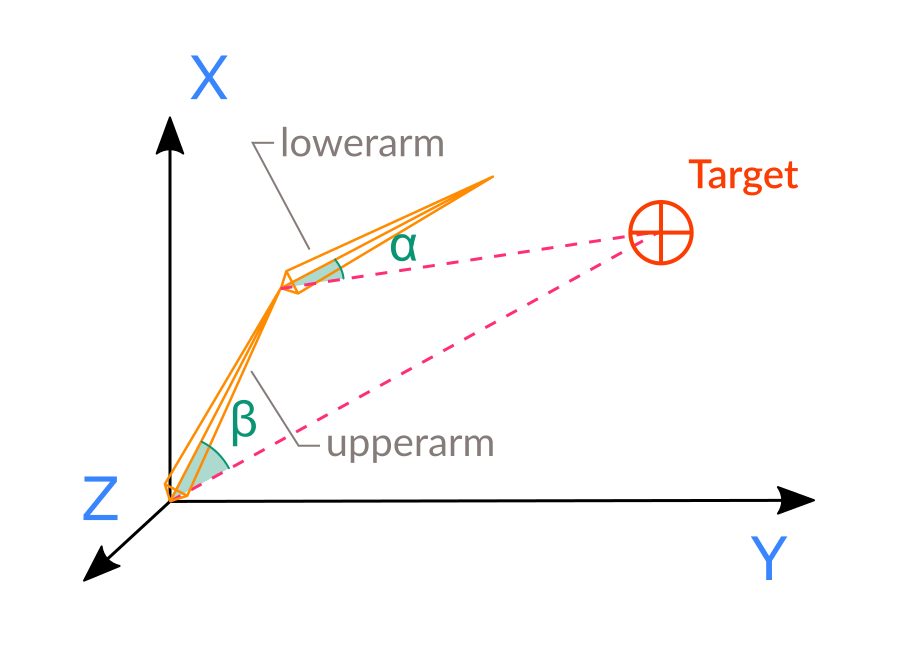Inverse kinematics¶
This tutorial is a follow-up of Working with 3D skeletons.
Previously, we were able to control the rotations of bones in order to manipulate where our arm was (forward kinematics). But what if we wanted to solve this problem in reverse? Inverse kinematics (IK) tells us how to rotate our bones in order to reach a desired position.
A simple example of IK is the human arm: While we intuitively know the target position of an object we want to reach for, our brains need to figure out how much to move each joint in our arm to get to that target.
Initial problem¶
Talking in Godot terminology, the task we want to solve here is to position the 2 angles on the joints of our upperarm and lowerarm so that the tip of the lowerarm bone is as close to the target point (which is set by the target Vector3) as possible using only rotations. This task is calculation-intensive and never resolved by analytical equation solving, as it is an under-constrained problem which means that there is more than one solution to an IK problem.

For easy calculation in this chapter, we consider the target being a child of Skeleton. If this is not the case for your setup you can always reparent it in your script, as you will save on calculations if you do so.
In the picture, you see the angles alpha and beta. In this case, we don’t use poles and constraints, so we need to add our own. On the picture the angles are 2D angles living in a plane which is defined by bone base, bone tip, and target.
The rotation axis is easily calculated using the cross-product of the bone
vector and the target vector. The rotation in this case will be always in
positive direction. If t is the Transform which we get from the
get_bone_global_pose() function, the bone vector is
t.basis[2]
So we have all the information we need to execute our algorithm.
In game dev it is common to resolve this problem by iteratively closing to the desired location, adding/subtracting small numbers to the angles until the distance change achieved is less than some small error value. Sounds easy enough, but there are still Godot problems we need to resolve to achieve our goal.
- How to find coordinates of the tip of the bone?
- How to find the vector from the bone base to the target?
For our goal (tip of the bone moved within area of target), we need to know where the tip of our IK bone is. As we don’t use a leaf bone as IK bone, we know the coordinate of the bone base is the tip of the parent bone. All these calculations are quite dependent on the skeleton’s structure. You could use pre-calculated constants, or you could add an extra bone at the tip of the IK bone and calculate using that.
Implementation¶
We will use an exported variable for the bone length to make it easy.
export var ik_bone = "lowerarm"
export var ik_bone_length = 1.0
export var ik_error = 0.1
Now, we need to apply our transformations from the IK bone to the base of the chain, so we apply a rotation to the IK bone, then move from our IK bone up to its parent, apply rotation again, then move to the parent of the current bone again, etc. So we need to limit our chain somewhat.
export var ik_limit = 2
For the _ready() function:
var skel
func _ready():
skel = get_node("arm/Armature/Skeleton")
set_process(true)
Now we can write our chain-passing function:
func pass_chain():
var b = skel.find_bone(ik_bone)
var l = ik_limit
while b >= 0 and l > 0:
print( "name":", skel.get_bone_name(b))
print( "local transform":", skel.get_bone_pose(b))
print( "global transform":", skel.get_bone_global_pose(b))
b = skel.get_bone_parent(b)
l = l - 1
And for the _process() function:
func _process(delta):
pass_chain(delta)
Executing this script will pass through the bone chain, printing bone transforms.
extends Spatial
export var ik_bone = "lowerarm"
export var ik_bone_length = 1.0
export var ik_error = 0.1
export var ik_limit = 2
var skel
func _ready():
skel = get_node("arm/Armature/Skeleton")
set_process(true)
func pass_chain(delta):
var b = skel.find_bone(ik_bone)
var l = ik_limit
while b >= 0 and l > 0:
print("name: ", skel.get_bone_name(b))
print("local transform: ", skel.get_bone_pose(b))
print( "global transform:", skel.get_bone_global_pose(b))
b = skel.get_bone_parent(b)
l = l - 1
func _process(delta):
pass_chain(delta)
Now we need to actually work with the target. The target should be placed somewhere accessible. Since “arm” is an imported scene, we better place the target node within our top level scene. But for us to work with target easily its Transform should be on the same level as the Skeleton.
To cope with this problem, we create a “target” node under our scene root node and at runtime we will reparent it, copying the global transform which will achieve the desired effect.
Create a new Spatial node under the root node and rename it to “target”.
Then modify the _ready() function to look like this:
var skel
var target
func _ready():
skel = get_node("arm/Armature/Skeleton")
target = get_node("target")
var ttrans = target.get_global_transform()
remove_child(target)
skel.add_child(target)
target.set_global_transform(ttrans)
set_process(true)